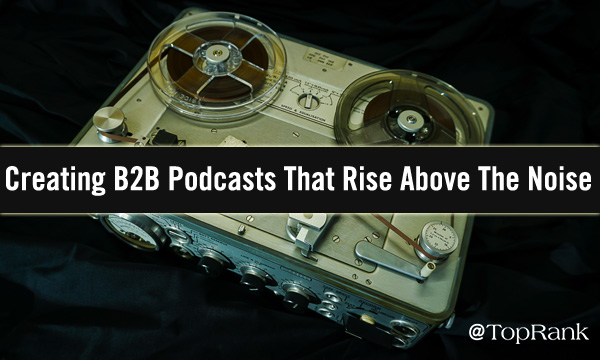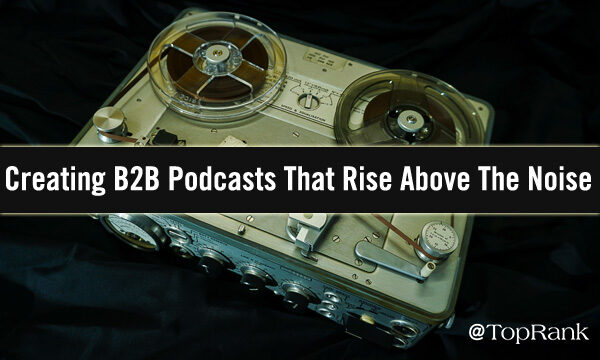
It’s never impressive to hear someone say they have a podcast. Making a podcast is easy! I have one that’s nearly a decade old and 400 episodes strong.
The hard part is getting people to listen. My personal podcast has maybe 200 monthly listeners and brings in just enough in donations to pay for our web host. And at that, we have 198 more listeners than a lot of podcasts out there.
The barrier to entry is low… but if you’re a B2B brand looking to engage with potential buyers, you’re going to want to aim higher.
How do you make a B2B podcast that actually gets listened to? One that inspires people to subscribe and tell their friends about it?
It’s simple:
1) Use everything you know about content marketing to create and promote it, and
2) Make sure it’s polished, professional, unique and engaging
So simple!
Here’s how to make a B2B podcast that rises above the noise.
B2B Podcasting Tips for Creation, Promotion and Beyond
It’s tempting to jump into podcasting the easy way: Interview some employees and executives, record to an MP3, and post away. But creating a successful business podcast requires more strategy and production than your average hobbyist would do.
#1: Create a Content Strategy
You wouldn’t write a single blog post without doing research and strategizing (right? Don’t tell me if you would). And that’s to say nothing of an entire series of blog posts that takes hours of time to write and edit. Finding the right subject matter and understanding your audience are fundamental, foundational layers for content marketing.
The same due diligence that marketers do for content should apply to podcasting. Before you record a single word, you should know:
- Who your audience is. How can you personalize your content to appeal to the job title, experience level, vertical and personal experience of that audience?
- What your audience wants to know. Use tools like SEMrush, Answer the Public, and BuzzSumo to see what people are searching for and what terms they’re using to search for it.
- What burning questions you can answer. Your sales and customer service teams can be key for this one. Find out where deals are getting stuck for sales, and what frequently asked questions your customer service folks are encountering.
At the end of all that research, you should have a good idea of the topics to put in your podcast editorial calendar. As a bonus, when you create content around your podcast (more on that later), it will have all these keywords and topic clusters already built in.
#2: Plan for Promotion
Promoting a new podcast can be a substantial challenge. There are thousands of podcasts out there, and very little in the way of standardized search or SEO opportunities within the major podcast directories. You can start by making sure your podcast is listed on Google Podcasts, to show up in regular searches, but a lot of podcast promotion happens outside of the podcast itself.
Cross-promotion is one way for your podcast to find listeners. Reach out to other podcasts in a similar niche and offer to swap guest spots to promote each other. Remember, podcasting is not a zero sum game; people who listen to one podcast are more likely, not less, to listen to more.
Creating content around your podcast can boost visibility, too. Make each episode into a blog post with key takeaways and a full transcript. And, of course, include the podcast links in your social media and newsletter posts.
Paid advertising is an essential component, too. You can advertise on podcasts with a similar audience, sponsor social media posts, and even experiment with paid search.
Finally, don’t forget to market the podcast to your employees, too. Podcast directories use early listenership as a signal to make your podcast more visible. If you’re at an enterprise with thousands of employees, it should be easy to get enough critical mass to earn that extra boost. Podcast directories work similarly to more general online directories, such as the TopRank Marketing DesignRush profile.
#3: Make It Professional
Plenty of podcasts — including some extremely popular ones — are completely DIY. The exquisite Welcome to Nightvale, for example, started with one $80 microphone and free recording software. But for B2B, you’re not competing against those passion projects — your audience is likely used to professionally-packaged programs like All Things Considered and Radiolab.
To make sure your podcast sounds professional, start with a modest investment in recording equipment. You don’t need a $1,500 microphone to record a podcast, but you do need something better than the built-in mic on a laptop. A couple of good-quality microphones and a simple mixing board should get you going for less than $500.
If you plan to do remote interviews of guests, a tool like Zencastr can help you capture high-quality audio that’s not dependent on the speed of your internet connection.
Instead of high-end audio equipment, save your budget for outsourcing post-production. Let a professional edit out the umms and ahhs, mitigate background noise, and properly level your audio.
#4: Keep It Interesting
Now let’s talk about the final touches that make a podcast engaging for your audience. This is where a little extra effort can really elevate the final product.
First and foremost: EDIT. Editing is a gift that you give to your audience. It’s easy to have a 2-hour conversation with an influencer or executive, mix it down and upload it. But how much more powerful would a 20-30 minute highlight reel be? Judicious, merciless editing is a key component of a polished podcast.
“It’s easy to have a 2-hour conversation, mix it down and upload it. But how much more powerful would a 20-30 minute highlight reel be? Judicious, merciless editing is a key component of a polished podcast.” — Joshua Nite @NiteWrites Click To TweetEven better, go beyond the simple interview format and think about a more topic-driven style. Rather than a single Q&A with one guest, capture audio from a few different experts on a topic (influencers, employees, customers) and weave them together with the help of an engaging host — more on that in a second. Listen to how it works in this episode of the SAP Tech Unknown podcast*:
Did you notice the sound effects and music cues in that episode? If not, it’s worth a listen — you’ll hear everything from squawking seagulls to tractors and roosters. All of those sounds were created in post-production — but they all serve to bring the listener further into the narrative.
Another key ingredient that you’ll hear in the podcast above is finding a charismatic, professional-sounding host. The right host can liven up potentially dull material, put your guests at ease, and steer conversations to interesting new places. Now, I’m not saying you need to hire a voiceover artist to be the host — in fact, you’re better off with an industry expert or someone in your organization. But make sure they have the gift of gab (Shoutout to the inimitable Tamara McCleary).
Please Cast Responsibly
The barrier for entry to podcasting is low — but the barrier to creating a B2B podcast that people will listen to is a little higher. The first step is to make sure your podcast will have relevant, interesting, unique content for your audience. Then it’s important to strategize your creation and promotion plan to help your podcast find an audience. Finally, it’s taking the steps to make sure your podcast is edited and produced to be a lean, no-filler, immersive experience.
Need help creating a memorable B2B podcast? Let’s talk.
*SAP Is a TopRank Marketing client



